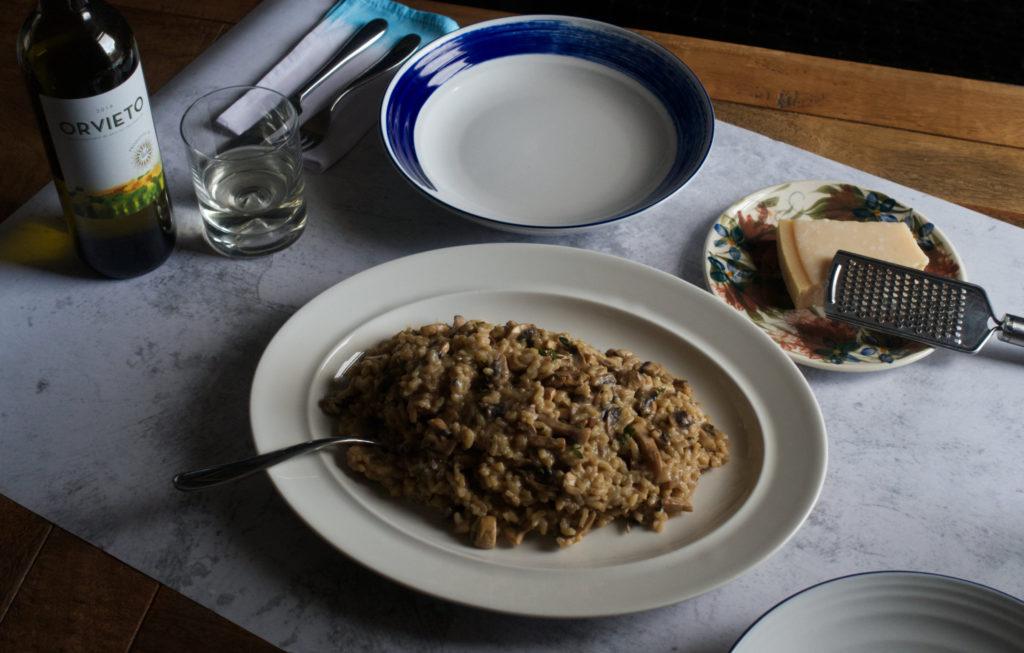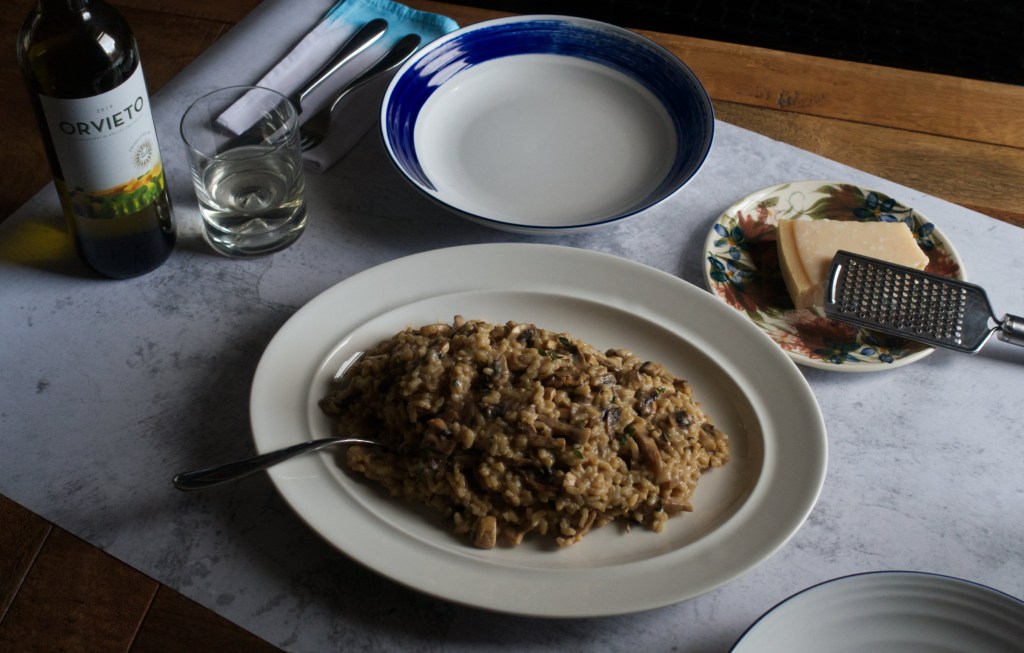I don’t know about you, but I’m finding it a little hard to get out of my own head, these days. I’m trying not to think about how long life has felt stalled, how many days we have spent inside the same four walls, save for a daily constitutional, how many more we have to do. Those projects of early lockdown — jigsaws, learning a new language, finally reading Moby Dick — have lost their allure. There’s little to define the days, or break them up; the weekends feel the same as the weekdays.
In an attempt to get close to culinary mindfulness (or mindlessness, I really don’t mind) I’ve found myself reaching for dishes that don’t require a lot of thinking, but do need attention. Risotto is meditative: anyone who knows anything about risotto knows that it must be stirred for ages. But it’s more than that: to make a risotto properly, you have to pass through a number of stages, one, two, three, four, five, six, something I find immeasurably comforting. Perhaps it’s the treadmill nature of the days, weeks, months bleeding into one another, repeating themselves, but the predictable progression of a risotto is soothing.
So, the stages: il soffrito: the gentle frying of the base until soft and translucent, usually onions or shallots, sometimes garlic, carrots and celery. The second stage is la tostatura, when the rice is toasted in the oil in the pan: this toasting stops the rice from becoming mushy when the liquid is added. Next, lo sfumato, adding the wine to the pan. The sigh that the wine makes as it hits the hot pan is more cathartic and more stress relieving that a sports massage. I physically feel my shoulders fall a couple of inches when it happens.
Now, the main event, lat cottura, the gradual adding of stock and cooking of the rice, the stirring, the checking. Next, il riposo, the brief rest for both you and the rice: it gives the rice time for the temperature to drop slightly before you add the dairy, and for you, time to recover from the stirring, and ready yourself for the more vigorous final stage. That final stage is la mantecatura, and it’s my favorite: cold butter and parmesan is beaten into the risotto. Note that it is beaten, and not stirred: the action needs to be vigorous, more energetic than the normal risotto stirring, as you’re emulsifying the starchy stock and the butter and parmesan together to create a thick, glossy sauce, and give the dish its correct texture, all’onda, rippling like a wave. Consequently, it’s impossible to make a good risotto without lots of butter and cheese. As Italian cookery writer Anna del Conte says of risotto, ‘if you don’t want butter, eat something else’.
Although I’ve given a time estimate, it’s hard to put a number on risotto: it depends on the age of your rice, and the exact heat you’re cooking over. The rice will be ready when it’s ready, and perhaps that’s part of its appeal for me right now: enough time, and enough stock, and it will get there. But it’s far more important to be led by how the risotto looks and sounds than what your timer says. You know that your pan is hot enough when you hear the wine exhale as it hits the rice. You can hear when it’s time to add a ladleful more stock, the rice will bubble a little more noisily, hissing against the bottom of the pan. You can actually see when the risotto has absorbed as much stock as it can, when the rice is suspended in individual grains through the thick sauce. And when you add the butter and cheese, and have beaten it sufficiently into the rice, before your eyes, the dish will turn from translucent to opaque.

Wild mushroom risotto
Makes: Enough for 4
Takes: 1 hour
Bakes: No time at all
2 tablespoons olive oil
2 banana shallots, peeled and finely chopped
⅔ oz dried porcini mushrooms
7 oz chestnut mushrooms, half sliced, half diced
7 oz arborio or carnaroli rice
2 ½ fl oz white wine
1 ½ oz parmesan or pecorino, finely grated
1 ½ oz butter
A few sprigs of tarragon, finely chopped
- Pour four cups of boiling water over the dried mushrooms, agitate with a spoon, and leave to stand while you continue other preparation
- In a large, heavy bottomed pan, over a medium-high heat, cook the sliced mushrooms until they give up their water and start to brown. Add ⅓ oz butter and fry for a couple of minutes more, before setting the mushrooms to one side.
- Add the oil to the (now empty) pan, turn the heat down to low, and cook the diced shallot very gently for 10 minutes until softened, but not colored
- Turn the heat up to medium, add the rice, stir it into the soft shallots, and cook for a couple of minutes. Add the wine and let it hiss and reduce
- Strain the soaked mushrooms from the water, roughly chop them, and set them to one side. Add a ladleful of the mushroom water to the rice, and cook, stirring the rice every so often, until the mushroom water has nearly completely evaporated
- Add another ladleful of mushroom water and continue stirring, letting the water almost bubble away, and then adding more water. After 20 minutes, start checking the rice: you’re looking for it to have a small bite in the middle of the rice, but a pleasant one, no chalkiness at all. If the rice is still too hard, add more of the infused water, stir, bubble, check again. The finished sauce should be thick but mobile, rippling around the cooked grains of rice. Remove from the heat
- Once the rice is cooked, stir the fried and soaked mushrooms and through the rice
- Beat first the butter, and then the parmesan or pecorino through the rice, until the saucy liquid surrounding the grains of rice thickens, pales and turns from translucent to opaque. Season generously, taste, and adjust as necessary. Sprinkle with tarragon and serve immediately
This article was originally published on Spectator Life.


















